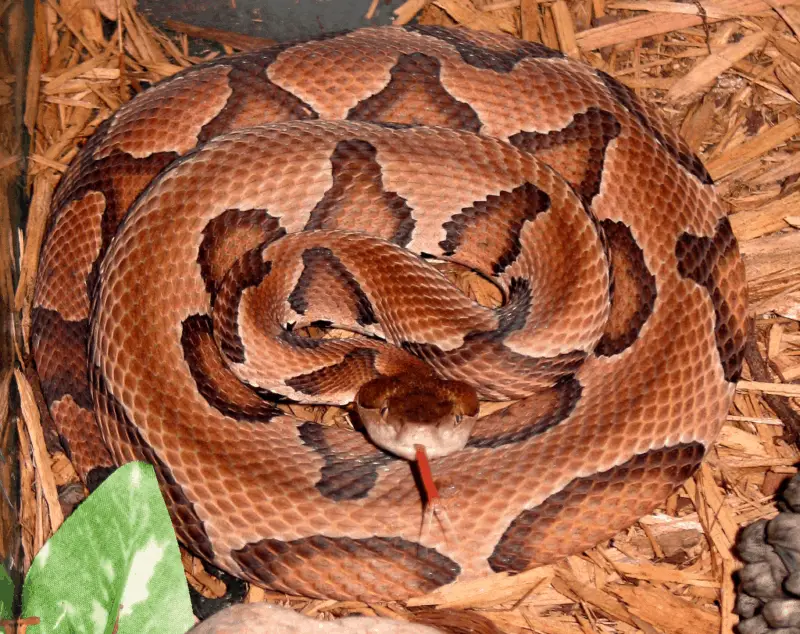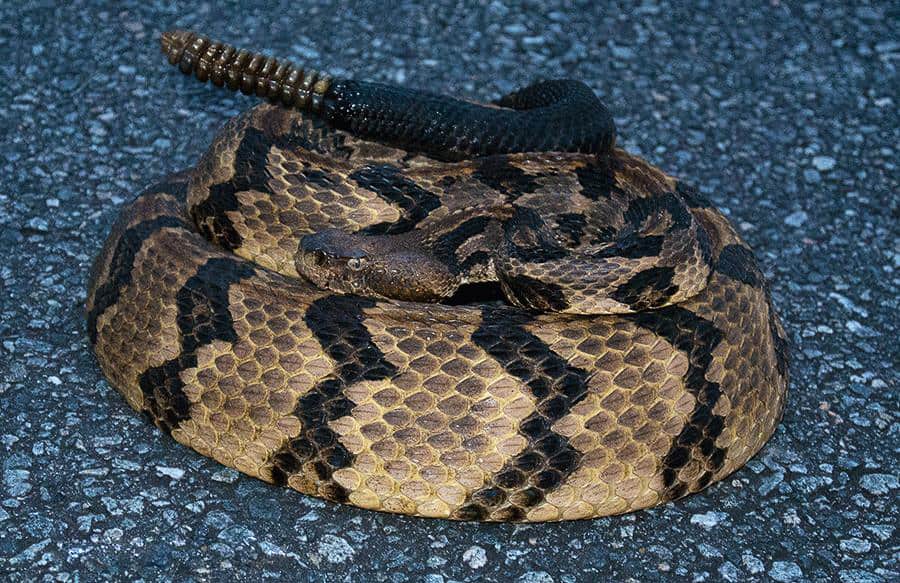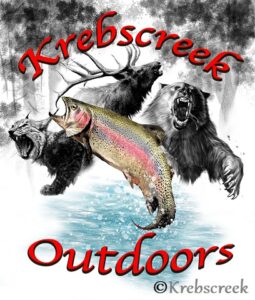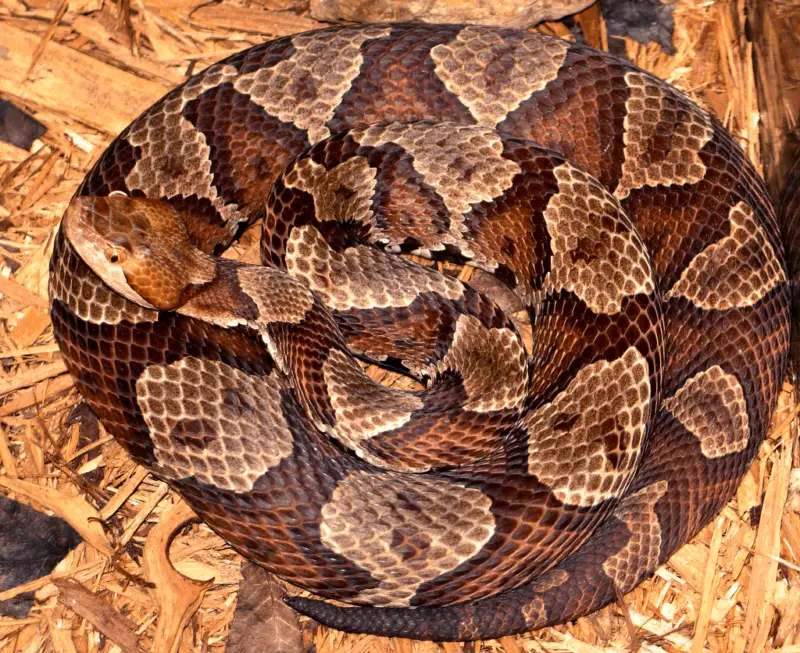There are two venomous snake species in Maryland. They are the Timber Rattlesnake and the Eastern Copperhead.
Despite the potential danger these snakes present, they’re also a vital part of the ecosystems that they inhabit. Their main contribution is keeping rodent populations and the pests accompanying rodents, such as fleas and ticks, in check.
Both of these snakes are potentially dangerous to humans. In fact, according to the World Population Review, Maryland’s venomous snakes bite around 42 people in an average year.
Anyone who spends time in Maryland’s outdoors will be safer if they learn where the populations of Timber Rattlesnakes and Copperheads are within the state. It’s also important to know how to recognize these snakes and how to safely coexist with them.
This comprehensive guide will give you the information you need to stay safe in the outdoors with Maryland’s venomous snakes.
Pit Vipers: The Venomous Masters of Infrared Detection
Maryland’s two venomous snakes are pit vipers as are all Rattlesnakes, Copperheads, and Cottonmouths. Pit Vipers belong to the Crotalinae subfamily of the Viperidae family of venomous snakes. Let’s learn a little more about them.
What Makes Pit Vipers Unique?
- Infrared-Sensing Pits:
A defining feature of pit vipers is the deep facial pit between their nostril and the eye on each side of their head. These specialized infrared-detecting organs allow pit vipers to sense heat emitted by prey. This adaptation enables them to:- Detect body heat from up to 1 meter away.
- Strike prey with pinpoint accuracy, even in complete darkness.
- Triangular Heads and Vertical Pupils:
- Head Shape: Pit vipers are recognized by their distinct triangular-shaped heads, which house their venom glands.
- Eyes: They have vertical elliptical-shaped pupils.
- Venomous Fangs:
Pit vipers have hollow fangs connected to venom glands. These fangs fold back against the roof of their mouth when not in use.
Ecological Importance
Pit vipers serve as a check to rodent populations. Despite their fearsome reputation, these snakes are vital to the health of many habitats.
The Nongame and Endangered Species Conservation Act protects all snake species in Maryland.

Eastern Copperhead (Agkistrodon contortrix)
The Eastern Copperhead is a pit viper native to the eastern United States.
What Do Eastern Copperheads Look Like?
| Size | *Adults range from 20 to 37 inches (50 to 95 cm) in length. |
| Coloration | *Reddish-tan to grayish-tan bodies. *Overlaid with dark brown, hourglass-shaped markings. *Heads are dark coppery brown, giving them the name “Copperhead.” |
| Body Shape | *Stout and heavy-bodied snakes. *As with all pitvipers, their heads are triangular and appear oversized in relation to their necks. |
| Conservation Status | *Common throughout the state of Maryland. |
Taxonomy of Maryland’s Eastern Copperhead Snakes
Copperhead snakes are found across Maryland and are now recognized as a single species: the Eastern Copperhead (Agkistrodon contortrix).
In the past, these snakes were classified into different subspecies, including the Northern Copperhead, Southern Copperhead, and Osage Copperhead. However, recent DNA studies revealed minimal genetic differences between them. As a result, these subspecies were combined into a single taxonomic group under the Eastern Copperhead name.
Where Do Eastern Copperheads Live in Maryland?

Eastern Copperheads live throughout Maryland. However, they are absent from a few counties along the eastern shore. They are found in rock piles, rocky woodlands, and river bottoms. The leaf and plant debris in these areas provide cover for them to hide.
Eastern Copperhead Behavior
Copperheads are dangerous because they use camouflage as their number one defense mechanism. In other words, these snakes choose to lie perfectly still rather than flee most of the time. Their camouflage helps them blend in with leaf litter and other ground debris.
When they feel threatened, they occasionally mimic the tail vibration of a rattlesnake. But, in most cases, they choose to lie perfectly still.
Most copperhead bites on humans occur when the person steps on or near the snake.
What Do Copperheads Eat?
Copperhead snakes are opportunistic feeders. They eat large insects, spiders, small rodents, small animals, birds, and other reptiles.
How Dangerous Are Copperheads?
A Copperhead can bite and inject venom from the time they are newly born. Like most pit vipers, they have hemotoxic venom.
Most copperhead bites are not life-threatening. On the other hand, any bite from this snake is a medical emergency and should be treated as such. Prompt medical attention increases the chance of a good outcome.
Copperhead bites can cause intense pain, shock, and swelling. Their bites also have the potential to cause blood in urine, tissue damage, and kidney failure.
An interesting study has found that Copperhead venom contains a protein called contortrostatin. Contortrostatin has been found to stop the growth of cancer cells in mice.
Rattlesnakes in Maryland
Rattlesnakes are pit vipers. See the description of pit vipers above.
What Maryland’s rattlesnakes have in common with most other rattlesnake species is their rattle.
- Most rattlesnakes have a rattle at the end of their tail, comprised of hollow, loosely interlocked keratinous scales.
- Normally, a rattlesnake adds a new segment to its rattle each time it sheds its skin.
- An agitated rattlesnake rapidly vibrates its tail, causing the segments of its rattle to vibrate together, creating a rattling or buzzing sound.
- Not all rattlesnakes rattle before they strike. Sometimes, they lose their rattles due to injury, and sometimes, they choose not to rattle.

Timber Rattlesnake (Crotalus horridus)
Timber Rattler and Canebrake Rattlesnake are both common names for the Timber Rattlesnake. Generally, in higher-elevation habitats, they are called Timber Rattlesnakes. On the coastal plain, though, they’re called Canebrake Rattlesnakes.
What Do Timber Rattlesnakes Look Like?
| Size | *Average length: 36 to 60 inches (0.91 to 1.52 m). *Rare cases reported: Up to 7 feet (2.13 m). |
| Coloration | *General base color: Yellowish-brown to grey-brown. *Chevron pattern: Dark brown to black chevrons on their back and sides against a lighter base color. *Back stripe: Rusty to reddish stripe running down their back. *Tail color: Dark brown or black. |
| Melanistic Variation | *Some timber rattlesnakes exhibit a dark, melanistic color morph. *These snakes can appear almost entirely black. *The tail is darker than the rest of the body in this morph. |
| Behaviors | *These snakes are excellent climbers. In fact, timber rattlers have been found in trees at heights of more than 80 feet. *The experts have proven that timber rattlesnakes help control Lyme disease. This is because as they consume rodents, they’re also consuming ticks. A timber rattler will consume 2,500 to 4,500 ticks per year, depending on the location. |
| Conservation Status | Endangered Species |
Where Do Timber Rattlesnakes Live in Maryland?

The Maryland Department of Natural Resources states that the Timber Rattlesnake is endangered. These snakes are found from the Susquehanna River to the western portion of Maryland.
The Timber rattlesnake lives in various habitats. These include mountainous forests, pine forests, and farm fields. They can also be found in swampy areas and river floodplains. In the winter, they are found hibernating in crevices in the ground.
What Do Timber Rattlesnakes Eat?
Timber rattlers prey on small mammals such as mice, rats, squirrels, and chipmunks. They also eat small birds, other reptiles, and amphibians.
How Dangerous Are Timber Rattlesnakes?
- Timber Rattlesnakes are among the most dangerous snakes in North America. This is due to their long fangs and high venom yield. 1% to 10% of untreated Timber Rattlesnake bites result in a fatality.
- Fortunately, 40% to 60% of the time, they produce dry bites. In other words, although their fangs penetrate the body, they do not inject any venom.
- These snakes produce hemotoxic venom. Timber Rattlesnake bites sometimes cause serious complications. These include shock, seizures, coma, internal bleeding, blood clots, and deep tissue damage.
Maryland’s Venomous Snakes in Winter: Insights into Brumation
During winter, Maryland’s snakes, like all reptiles, enter a dormant state called brumation—a hibernation-like period. Because snakes are ectothermic (cold-blooded) and cannot regulate their body temperature internally, they slow their metabolism and become inactive during the colder months.
Brumation Habits
- Solo vs. Communal Brumation: Some snakes brumate alone, while others gather in communal dens. For example, Eastern Copperheads and Timber Rattlesnakes often share dens, which may house up to 60 snakes.
- Mixed-Species Dens: Interestingly, it’s not uncommon to find non-venomous snakes, such as Black Rat Snakes, sheltering alongside venomous snakes.
Regional Variations
- In warmer areas, snakes may only seek shelter on the coldest days.
Where Snakes Spend Winter
Snakes seek out protected spots to brumate, such as:
- Rock crevices
- Hollow logs
- Fissures on rocky hillsides
They often choose south-facing slopes because these areas receive more sunlight, providing additional warmth during winter.
Avoiding Snake Bite
Snakes, including venomous ones, commonly rely on camouflage to hide from potential threats. They often remain perfectly still to avoid detection. If you’re walking in the woods and unknowingly get too close, a snake might not move, hoping you’ll pass by. This is particularly true of copperheads. Many bites happen when someone accidentally steps on or close to the snake. To stay safe in snake habitats, always watch where you step and where you place your hands.
Another common cause of snake bite is attempts to capture or kill a snake. Remember, venomous snakes can strike instantly, delivering a potentially life-threatening bite. The safest approach is to keep a safe distance and leave them alone.
Dressing for Snake Country
- High-top leather boots and long pants are both wise ideas.
- Also, wear loose-fitting denim. If there’s a gap before the snake’s fangs touch your skin, your chances of being envenomated are lower.
- In the absence of high-top leather boots, some people wear snake gaiters
Symptoms of Venomous Snake Bites
Maryland Poison Control typically registers 100 snake bite cases annually. Roughly half attributed to bites from venomous snakes, particularly those inflicted by copperheads.
Some of the symptoms you may experience when a venomous snake bites you include:
- Discoloration in the area of the bite.
- Swelling in the area of the bite.
- Loss of muscle coordination.
- Tingling sensation in the area of the bite.
- Feeling nauseous.
- Having a faster heartbeat or rapid pulse.
What Should You Do if You Are Bitten?
If you or someone you are with has suffered a venomous snakebite, time is of the essence. Because the sooner a victim receives antivenom, the less chance the venom in their body has to cause harm. In other words, it is important to seek immediate medical attention.
Do not attempt to kill the snake for identification purposes. This gives the snake a chance to bite you again. Also, consider that severed snakeheads can still bite and envenomate and often do. If you have a phone, take a picture of the offending reptile. Otherwise, get started on your way to the nearest hospital.
First Aid for Snake Bite Victims
- Remain calm and limit your movements. Do not run. If you must hike back to a vehicle, do it calmly and deliberately. Put as little stress on your heart as possible.
- Keep the area of the snake bite below the heart level and never above the heart level. Keeping the bite below the heart level will reduce the venom’s flow. However, holding the bite above your heart level will increase the venom’s flow.
- Remove all constricting items such as bracelets, watches, or rings before swelling occurs.
- Remember that using a cold compress on a venomous snake bite is not advisable. The cold may cause the local blood vessels to constrict and spread the venom faster.
- You can wash the affected area like any other wound with soap and water.
- You may cover the bite area with a moist dressing to reduce the swelling.
- Get medical attention as soon as possible. Call the hospital to tell them a venomous snake has bitten you. So they can have antivenom ready to give you when you arrive.
- A person whom a venomous snake has bitten may go into shock. If this happens, lay them flat and cover them with a blanket.
Conclusion
Maryland’s venomous snakes, the Eastern Copperhead and Timber Rattlesnake, are more than just potential hazards. They’re vital contributors to the state’s ecosystems. By controlling rodent populations, they help maintain balance in nature. In turn, this reduces the spread of diseases like Lyme disease.
Understanding these snakes’ habitats, identifying their unique features, and recognizing their behaviors can significantly reduce your snake bite risk. Whether hiking, gardening, or exploring Maryland’s outdoors, staying alert and respecting the space of these dangerous reptiles is key to a safe and enjoyable experience.
It’s also important to remember that these snakes are protected under Maryland law, emphasizing their ecological importance. By learning to coexist with them, you not only ensure your safety but also support the preservation of these remarkable reptiles.
Armed with the knowledge from this guide, you’re better prepared to appreciate Maryland’s natural beauty while staying safe. Respect, awareness, and caution are your best tools for navigating the shared spaces we call home. Stay safe and enjoy the outdoors responsibly!
You might also like Wild Cats in Maryland – Krebs Creek.
Recent Posts
The only venomous snakes in Washington State are Northern Pacific Rattlesnakes. The Northern Pacific Rattlesnake (Crotalus oreganus oreganus) is a sub-species of the Western Rattlesnake. Anyone...
Skunks are not classified as true hibernators. But they go into a state of torpor when the weather gets cold. Skunks are light sleep hibernators, along with opossums, bears, and raccoons. ...

